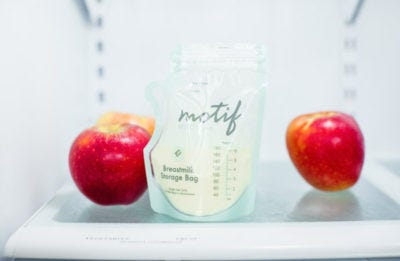Breastmilk has a wonderful shelf life. Unlike most foods and beverages, breastmilk retains live cells and enzymes that actually fight off foreign microbe growth. If left out, environmental bacteria and other microbes that land in the milk are eliminated by these cells. For this reason, unpasteurized human milk can be left out for up to 4 hours at room temperature before needing to be refrigerated, unlike most other items at 2 hours.
Formula is ultra-processed, and actually contains foreign bacteria from going through processing, and therefore has much more strenuous prepping and storing requirements, much like other foods.


Refrigeration and freezing guidelines also look different. Most food and beverage items need to be discarded after 3 days in the refrigerator if unused. Even less if the contents have come in contact with saliva, say, a used bottle, at 24 hours. Clean breastmilk can be kept refrigerated for 4 days! This is particularly helpful for mothers who pump just enough for the following day or two, and do not need to worry about freezing and immediately thawing the contents if intending to use it within that time frame.
If freezing, breastmilk can be kept up to 6 months in the main storage compartment of the freezer, although some suggest 12 months is acceptable, or up to 12 months in a deep freezer, since temperatures remain lower and it is typically opened less.


Something to keep in mind is amounts when storing milk, whether freezing or refrigerating. To prevent wasting milk, the recommendation to store amounts roughly needed in a feeding, and allowing a little space to account for the milk expanding once frozen.
For example, a younger infant will take in approximately 2-3 ounces, and an older infant may need 4-5. If a bottle of milk has been used, and any remains, it cannot be frozen, and needs to be used within 24 hours. It can be left out at room temperature up to 2 hours, and otherwise needs to be refrigerated until needed. Remember to discuss safe handling with the care provider, as well!
Handling Frozen Breastmilk
Good inventory practice includes the first-in, first-out method. Labeling the date expressed or pumped helps with this, too. Using the earliest-stored milk helps prevent waste and lesser quality.Thawing is an important process to learn. When done properly and safely, the contents of the milk are better preserved, and bacteria or mold growth is under control. Thawed milk now has to be handled like any other food or beverage in terms of longevity and refrigeration. To safely thaw and use thawed breastmilk, consider the following:
- Use the refrigerator to thaw overnight or warm water if needed faster. Bowls of warm water work nicely.
- NEVER MICROWAVE. This not only breaks down components in the breastmilk, but can create dangerous hot spots.
- Use within 2 hours at room temperature, or within 24 hours if kept refrigerated.
- Milk cannot be refrozen* *Exception, if ice crystals still remain in the milk. This is especially important to remember in the case of a power outage.
- Contents of milk may separate, fat layers will appear. SWIRL to reconstitute, do not shake.


Storage Containers
Plastic bottles are not recommended. Use storage bags specifically designed for breastmilk storage, if at all possible. These will be BPA free, and the design makes labeling, storage amounts, and pouring much more appropriate, easier and safer!
If an alternative is needed, clean, food grade plastic containers or glass jars with tight-fitting lids may be used!
Breastmilk Storage Locations and Temperatures
|
Storage Method |
Temp. |
Longevity |
Tips |
|
Counter |
Room temp. Up to 77° F |
Ideally, use within 3-5 hours. |
Containers should be covered and kept as cool as possible. Discard leftover milk after your baby is finished feeding. |
|
Fridge |
39° F or colder |
Ideally, use within 3-5 days |
Store milk in the back of the refrigerator. Use an insulated bag to store milk in the back of the refrigerator at work. |
|
Freezer |
0° F or colder |
Ideally, use within 3 to 6 months |
Store the milk in the back of the freezer where the temperature will remain the most consistent. |
Resources
https://www.cdc.gov/breastfeeding/recommendations/handling_breastmilk.htm
Download PDF: https://www.cdc.gov/breastfeeding/pdf/preparation-of-breast-milk_H.pdf








